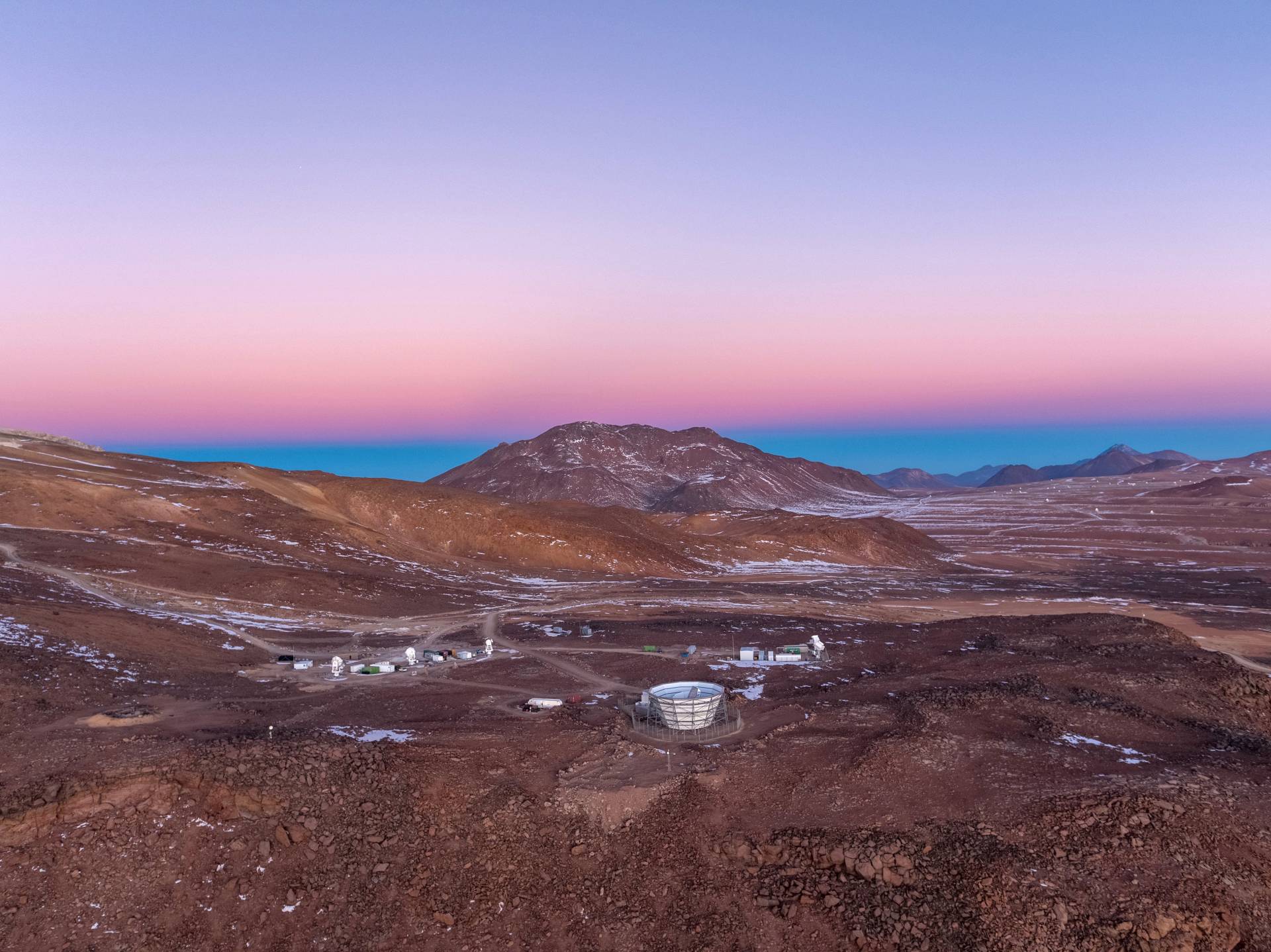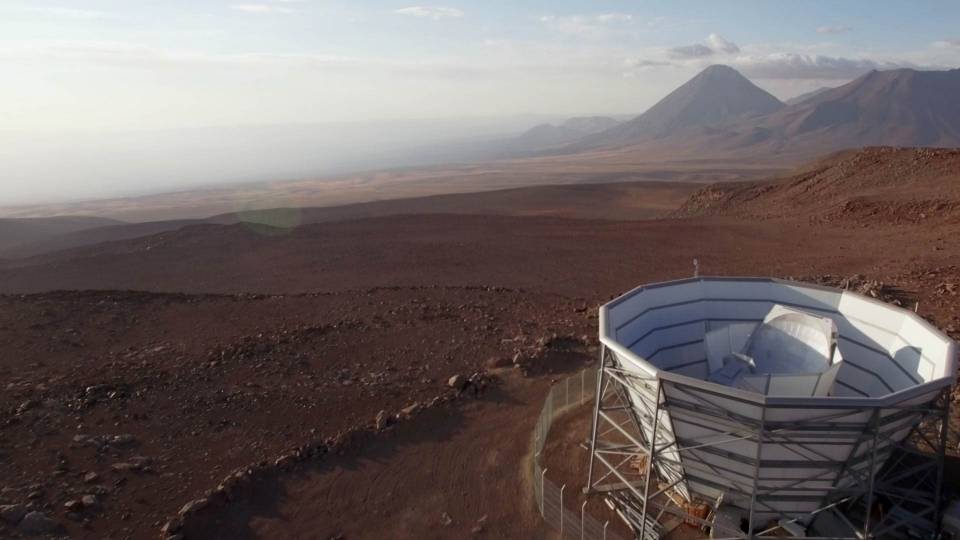Princeton astrophysicists have been involved at every stage of development for the Simons Observatory, a telescope under construction in Chile’s Atacama Desert that will equip them to study the universe's earliest history. Professor David Spergel (second from left) braved 5 degree F. windchill conditions to attend the groundbreaking ceremony held on June 30, using oxygen to supplement the thin air at 17,200 feet elevation. From left: Professor Adrian Lee of UC Berkeley, Professor Spergel, Professor Brian Keating of UC San Diego, Dr. Jim Simons of the Simons Foundation and Dr. Marilyn Simons of the Simons Foundation.
What was the universe like in the moments after its inception?
Princeton scientists will soon be better equipped to answer that question, thanks to a future commitment of $20 million made by the Simons Foundation. The funds will support five years of operations of the Simons Observatory, contingent upon the successful completion of the construction, which is currently underway in Chile’s Atacama Desert, at 17,200 feet in elevation. The official groundbreaking ceremony was held on June 30.
A consortium of astrophysicists will use the observatory to measure the cosmic microwave background (CMB), which provides a window to the physics of the earliest universe, the nature of dark energy, the properties of neutrinos and how gravity imposed structure on the universe.
“This is the largest, most sophisticated, ground-based CMB experiment yet,” said Lyman Page, the James S. McDonnell Distinguished University Professor of Physics and a member of the executive and planning boards for the observatory. “This is a very important project for the advancement of cosmology.”

The groundbreaking ceremony in the windswept high desert marked the official kickoff of the site, in preparation for the arrival of the four telescopes that will comprise the Simons Observatory.
The observatory involves researchers and support from Princeton University, University of Pennsylvania, University of California-Berkeley, University of California San Diego, Lawrence Berkeley National Laboratory, the Flatiron Institute and 40 partner institutions around the world.
“The continuing support and commitment to the Simons Observatory from the Simons Foundation and our partner institutions are game-changing to how cosmologists can tackle fundamental questions about the universe regarding its beginnings, its contents, its evolution and the physics governing all those aspects, said Suzanne Staggs, Princeton’s Henry DeWolf Smyth Professor of Physics, who is one of three rotating spokespersons for the observatory and lead of the instrument’s detector effort.
“The suite of instruments we are building allows us to gather data from half the sky across a huge range of scales and frequencies, in a way that has never been done before,” she said.
“The Simons Observatory is a flagship project in cosmology, supported by the Simons Foundation in partnership with the Heising-Simons Foundation and participating institutions,” said Greg Gabadadze, associate director of the Mathematics and Physical Sciences division of the Simons Foundation. “The project aims to define the research on the cosmic microwave background radiation in the next decade, with a focus on the fundamental physics imprints carried by the radiation from the earliest moments of the universe.”
A primary objective of the Simons Observatory is to search the sky for the signature of the gravitational waves generated immediately following the origin of the universe. Gravitational waves — possibly created by violent expansion in the fabric of space called inflation, a leading theory about the beginning of the universe — may induce faint but detectable polarization patterns in the CMB at microwave wavelengths that can be detected by specialized telescopes and cameras.
“This new commitment from the Simons Foundation will be transformative, not only for the Simons Observatory, but for cosmology as a whole,” said Brian Keating, Chancellor’s Distinguished Professor of Physics at UC San Diego’s Center for Astrophysics and Space Sciences, who is the director of the Simons Observatory. “It will support the operation of the largest, most complex, most ambitious observatory of its kind. It will allow our scientists to develop and test new models for the origin, evolution and structure of the universe using the largest such data set ever acquired.”
The Simons Observatory is located in Chile, on the west slope of the Andes in the Parque Astronómico, which is administered by the Comisión Nacional de Investigación Científica y Tecnológica. The site is one of the highest and driest places on Earth at 17,000 feet above sea level, making it one of the planet’s best locations for the observatory. The high elevation means that it lies above half of the Earth’s atmosphere. Because water vapor absorbs microwaves, a dry climate in a thin atmosphere allows scientists to detect even more of the faint cosmic microwave background radiation.
Once construction and installation of the Simons Observatory are completed, which was made possible with $60 million in funding previously provided by the Simons Foundation, this future commitment will fund observatory operations and data analysis from 2022 to 2027. The Simons Foundation is a longtime supporter of the quest to understand the early universe. Co-founded in New York City by Jim and Marilyn Simons, the foundation’s mission is to advance the frontiers of research in mathematics and the basic sciences.
“We are grateful for the generosity of the Simons Foundation,” said Page. “The Simons Observatory is a combination of very exciting science, cutting-edge experimental technique and state-of-the art data analysis.”





